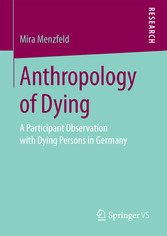
Anthropology of Dying - A Participant Observation with Dying Persons in Germany
von: Mira Menzfeld
Springer VS, 2017
ISBN: 9783658198268
Sprache: Englisch
282 Seiten, Download: 2141 KB
Format: PDF, auch als Online-Lesen
| Foreword | 5 | ||
| Acknowledgements | 7 | ||
| Funding | 9 | ||
| Contents | 10 | ||
| 1 Introducing dying | 19 | ||
| 1.1 Introduction | 19 | ||
| 1.2 Literature on dying | 23 | ||
| 1.3 Theoretical framework | 38 | ||
| 1.4 Coming to terms: Definitions | 43 | ||
| 1.5 Main arguments and structure of the chapters | 49 | ||
| 2 Fieldwork with dying persons | 52 | ||
| 2.1 Research context | 52 | ||
| 2.2 Research participants | 56 | ||
| 2.3 Methodology | 62 | ||
| 2.4 Research ethics and personal reflections | 71 | ||
| 2.5 Fieldwork in the native culture and contrast research | 80 | ||
| 2.6 Summary: Reflections on fieldwork with dying persons | 85 | ||
| 3 Becoming dying | 87 | ||
| 3.1 The beginning of the end | 87 | ||
| 3.2 How dying starts | 94 | ||
| 3.3 Dying as a vital conjuncture | 106 | ||
| 3.4 Summary: Becoming pre-exitally dying in Germany | 112 | ||
| 4 First experiences as a dying person | 114 | ||
| 4.1 Decision-making processes: Where and how to die | 114 | ||
| 4.2 Dying at home: An ambivalent ideal | 118 | ||
| 4.3 Decisions, requested and revised | 122 | ||
| 4.4 Institutions – gaining attractiveness | 126 | ||
| 4.5 Stressful movements | 131 | ||
| 4.6 Summary: Shaping the first time of dying | 136 | ||
| 5 Cultural models of dying | 137 | ||
| 5.1 Introducing cultural models | 137 | ||
| 5.2 Dying ‘well’: Approaching an ideal | 140 | ||
| 5.3 The umbrella model: Dying in dignity | 146 | ||
| 5.4 Cultural models of dying: Autonomy and serenity | 147 | ||
| 5.5 Summary: Cultural models of dying in Germany | 166 | ||
| 6 How it feels to be a dying person | 167 | ||
| 6.1 Feeling to be different from non-dying ones | 168 | ||
| 6.2 Feeling right: Display and concealment of emotions | 174 | ||
| 6.3 Fun and humor | 176 | ||
| 6.4 Envy and jealousy | 181 | ||
| 6.5 Simultaneity of emotions | 185 | ||
| 6.6 Summary: What dying feels like | 192 | ||
| 7 Changing perceptions in dying | 194 | ||
| 7.1 Changing sensory perceptions | 195 | ||
| 7.2 “…these drugs do me so much good”: Medication and technical devices | 202 | ||
| 7.3 Changing perceptions of relevance | 206 | ||
| 7.4 Regrets, achievements, and the triumph of having no family | 210 | ||
| 7.5 Summary: Physical, evaluative and relevance-related perceptions | 213 | ||
| 8 Emic perspectives on the course of dying | 215 | ||
| 8.1 Figuring out reasons for dying | 215 | ||
| 8.2 Temporalities of dying | 220 | ||
| 8.3 Ending dying | 225 | ||
| 8.4 Cornelia’s last hours | 231 | ||
| 8.5 Summary: Reflections on the course of dying | 233 | ||
| 9 Dying as liminality in the making | 234 | ||
| 9.1 Dying – a liminal situation? | 235 | ||
| 9.2 Lack and production of liminal guidance | 239 | ||
| 9.3 Emerging options for communitas | 246 | ||
| 9.4 Historical conditions of emerging liminality in dying | 252 | ||
| 9.5 Summary: Dying as liminality in the making | 254 | ||
| 10 Insights from and for dying | 255 | ||
| 10.1 Main findings | 255 | ||
| 10.2 Theoretical contributions | 260 | ||
| 10.3 Practical inspirations | 263 | ||
| 11 Epilogue | 267 | ||
| Reference list | 268 |








